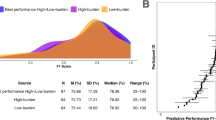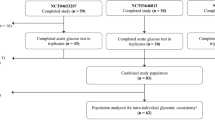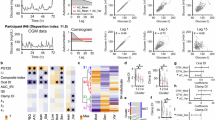Abstract
Objectives
Mango consumption is often restricted in diet consumed by people with diabetes due to concerns about its glycemic impact. This study aimed to compare the glycemic effects of mango consumption with those of white bread and glucose in subjects with and without type 2 diabetes (T2D).
Methods
We conducted a two-phase study involving 95 participants (45 with T2D, 50 non-diabetic). Phase 1 employed oral tolerance test (OTT) to assess immediate glycemic responses to mango (Safeda, Dasheri, and Langra), bread, and glucose. Phase 2 utilized continuous glucose monitoring (CGM) to evaluate glycemic profiles over three days.
Results
On OTT, in non-diabetic subjects, mango consumption resulted in non-significantly lower postprandial glucose peaks compared to glucose and bread, except Langra variety which showed lowest area under the curve for glucose of borderline significance. In subjects with T2D, mango varieties performed similarly to bread. CGM data revealed that mango consumption over three days resulted in a similar glycemic profile to bread in non-diabetic subjects and a lower glycemic profile in subjects with T2D, though most differences were statistically not significant. Mean Amplitude of Glycemic Excursion (MAGE) was significantly lower after mango ingestion as compared to bread in CGM data in subjects with T2D.
Conclusions
Data show limited glycemic impact of tested mango varieties, comparable to or lower than white bread, especially in T2D subjects. The significant reduction in MAGE observed with mango consumption suggests potential benefits for glycemic variability. With portion control in calorie restrictive diets, mango may be suitable for people with T2D.
This is a preview of subscription content, access via your institution
Access options
Subscribe to this journal
Receive 12 print issues and online access
$259.00 per year
only $21.58 per issue
Buy this article
- Purchase on SpringerLink
- Instant access to full article PDF
Prices may be subject to local taxes which are calculated during checkout





Similar content being viewed by others
Data availability
All data generated or analysed during this study are included in this published article and its Supplementary Information files.
References
Hills AP, Arena R, Khunti K, Yajnik CS, Jayawardena R, Henry CJ, et al. Epidemiology and determinants of type 2 diabetes in South Asia. Lancet Diabetes Endocrinol. 2018;6:966–78.
Ranasinghe P, Jayawardena R, Gamage N, Sivanandam N, Misra A. Prevalence and trends of the diabetes epidemic in urban and rural India: a pooled systematic review and meta-analysis of 1.7 million adults. Ann Epidemiol. 2021;58:128–48.
Zhang H, Zhou XD, Shapiro MD, Lip GYH, Tilg H, Valenti L, et al. Global burden of metabolic diseases, 1990-2021. Metabolism. 2024;160:155999.
Forouhi NG, Misra A, Mohan V, Taylor R, Yancy W. Dietary and nutritional approaches for prevention and management of type 2 diabetes. BMJ. 2018;361:k2234.
Pastors JG, Warshaw H, Daly A, Franz M, Kulkarni K. The evidence for the effectiveness of medical nutrition therapy in diabetes management. Diabetes Care. 2002;25:608–13.
Slavin JL, Lloyd B. Health benefits of fruits and vegetables. Adv Nutr. 2012;3:506–16.
Liu RH. Health benefits of fruit and vegetables are from additive and synergistic combinations of phytochemicals. Am J Clin Nutr. 2003;78:517S–20S.
Zarasvand SA, Mullins AP, Arjmandi B, Haley-Zitlin V. Antidiabetic properties of mango in animal models and humans: a systematic review. Nutr Res. 2023;111:73–89.
Masibo M, He Q. Major mango polyphenols and their potential significance to human health. Compr Rev Food Sci Food Saf. 2008;7:309–19.
Guevarra MT, Panlasigui LN. Blood glucose responses of diabetes mellitus type II patients to some local fruits. Asia Pac J Clin Nutr. 2000;9:303–8.
Foster-Powell K, Holt SH, Brand-Miller JC. International table of glycemic index and glycemic load values: 2002. Am J Clin Nutr. 2002;76:5–56.
Atkinson FS, Foster-Powell K, Brand-Miller JC. International tables of glycemic index and glycemic load values: 2008. Diabetes Care. 2008;31:2281–3.
Fang C, Kim H, Barnes RC, Talcott ST, Mertens-Talcott SU. Obesity-associated diseases biomarkers are differently modulated in lean and obese individuals and inversely correlated to plasma polyphenolic metabolites after 6 weeks of mango (Mangifera indica L.) consumption. Mol Nutr Food Res. 2018;62:e1800129.
Evans SF, Meister M, Mahmood M, Eldoumi H, Peterson S, Perkins-Veazie P, et al. Mango supplementation improves blood glucose in obese individuals. Nutr Metab Insights. 2014;7:77–84.
Evans SF, Beebe M, Mahmood M, Janthachotikun S, Eldoumi H, Peterson S, et al. Mango supplementation has no effects on inflammatory mediators in obese adults. Nutr Metab Insights. 2017;10:1178638817731770.
Keathley J, Kearney M, Garneau V, Toro-Martin J, Varin TV, Pilon G, et al. Changes in systolic blood pressure, postprandial glucose, and gut microbial composition following mango consumption in individuals with overweight and obesity. Appl Physiol Nutr Metab. 2022;47:565–74.
Kehar S, Misra A. Mango: a fruit too far in patients with diabetes? (or is it?). Diabetes Metab Syndr. 2020;14:135–6.
American Diabetes Association Professional Practice C. 2. Diagnosis and classification of diabetes: standards of care in diabetes-2024. Diabetes Care. 2024;47:S20–S42.
Gulati S, Misra A, Tiwari R, Sharma M, Pandey RM, Upadhyay AD, et al. Premeal almond load decreases postprandial glycaemia, adiposity and reversed prediabetes to normoglycemia: a randomized controlled trial. Clin Nutr ESPEN. 2023;54:12–22.
Misra A, Sharma R, Gulati S, Joshi SR, Sharma V, Ghafoorunissa, et al. Consensus dietary guidelines for healthy living and prevention of obesity, the metabolic syndrome, diabetes, and related disorders in Asian Indians. Diabetes Technol Ther. 2011;13:683–94.
Gulati S, Misra A, Tiwari R, Sharma M, Pandey RM, Upadhyay AD, et al. Beneficial effects of premeal almond load on glucose profile on oral glucose tolerance and continuous glucose monitoring: randomized crossover trials in Asian Indians with prediabetes. Eur J Clin Nutr. 2023;77:586–95.
Closas P, Coma E, Mendez L. Sequential detection of influenza epidemics by the Kolmogorov-Smirnov test. BMC Med Inf Decis Mak. 2012;12:112.
Ye F, Chen J, Hui Q, Liu D, Sun Q, Liu J, et al. Full title: prevalence and risk factors of overweight in Beijing infants basing generalized estimating equation: a longitudinal study. BMC Public Health. 2025;25:543.
Lucas EA, Li W, Peterson SK, Brown A, Kuvibidila S, Perkins-Veazie P, et al. Mango modulates body fat and plasma glucose and lipids in mice fed a high-fat diet. Br J Nutr. 2011;106:1495–505.
Roongpisuthipong C, Banphotkasem S, Komindr S, Tanphaichitr V. Postprandial glucose and insulin responses to various tropical fruits of equivalent carbohydrate content in non-insulin-dependent diabetes mellitus. Diabetes Res Clin Pr. 1991;14:123–31.
Contractor Z, Hussain F, Jabbar A. Postprandial glucose response to mango, banana and sapota. J Pak Med Assoc. 1999;49:215–6.
Rosas M Jr, Pinneo S, O’Mealy C, Tsang M, Liu C, Kern M, et al. Effects of fresh mango consumption on cardiometabolic risk factors in overweight and obese adults. Nutr Metab Cardiovasc Dis. 2022;32:494–503.
Stamper C, Safadi S, Gehr A, Asuncion P, Hong MY. Effects of fresh vs dried mango consumption on satiety and postprandial glucose in healthy adults. Metab Open. 2023;19:100253.
Pinneo S, O’Mealy C, Rosas M Jr, Tsang M, Liu C, Kern M, et al. Fresh mango consumption promotes greater satiety and improves postprandial glucose and insulin responses in healthy overweight and obese adults. J Med Food. 2022;25:381–8.
Sakaguchi CA, Nieman DC, Omar AM, Strauch RC, Williams JC, Lila MA. Influence of 2 weeks of mango ingestion on inflammation resolution after vigorous exercise. Nutrients. 2023;16:36.
Maldonado-Celis ME, Yahia EM, Bedoya R, Landazuri P, Loango N, Aguillon J, et al. Chemical composition of mango (Mangifera indica L.) fruit: nutritional and phytochemical compounds. Front Plant Sci. 2019;10:1073.
Pierson JT, Monteith GR, Roberts-Thomson SJ, Dietzgen RG, Gidley MJ, Shaw PN. Phytochemical extraction, characterisation and comparative distribution across four mango (Mangifera indica L.) fruit varieties. Food Chem. 2014;149:253–63.
Burton-Freeman BM, Sandhu AK, Edirisinghe I. Mangos and their bioactive components: adding variety to the fruit plate for health. Food Funct. 2017;8:3010–32.
Elizondo-Montemayor L, Hernandez-Brenes C, Ramos-Parra PA, Moreno-Sanchez D, Nieblas B, Rosas-Perez AM, et al. High hydrostatic pressure processing reduces the glycemic index of fresh mango puree in healthy subjects. Food Funct. 2015;6:1352–60.
Yashoda HM, Prabha T, Tharanathan R. Mango ripening: changes in cell wall constituents in relation to textural softening. J Sci Food Agric. 2006;86:713–21.
Research NIoN-ICoM. Indian food composition tables (2017). Available from. https://www.nin.res.in/ifct_book.html.
Acknowledgements
The authors would like to express their gratitude to all the study participants and the staff at Fortis CDOC Hospital for Diabetes, Metabolic Diseases and Endocrinology, for their cooperation. Special thanks are extended to Dr. Seema Gulati, Dr. Amrita Ghosh, Ms. Koel Dutta, and Ms. Kanika Tyagi for their support throughout the study.
Funding
This project was fully funded from a grant (File Number: 5/9/1309/2020-Nut) from Indian Council of Medial Research (https://www.icmr.gov.in/) New Delhi, India.
Author information
Authors and Affiliations
Contributions
SK and AM initiated the concept and contributed to the experimental design. SK was responsible for the preparation and storage of the mango pulp, while SK and IAA, VG conducted the study procedures. SPB, RMP, and RSR handled statistical analyses with inputs from AM. Finally, SK and AM prepared the manuscript.
Corresponding author
Ethics declarations
Competing interests
The authors declare no competing interests.
Additional information
Publisher’s note Springer Nature remains neutral with regard to jurisdictional claims in published maps and institutional affiliations.
Supplementary information
Rights and permissions
Springer Nature or its licensor (e.g., a society or other partner) holds exclusive rights to this article under a publishing agreement with the author(s) or other rightsholder(s); author self-archiving of the accepted manuscript version of this article is solely governed by the terms of such publishing agreement and applicable law.
About this article
Cite this article
Kehar, S., Bhatt, S.P., Pandey, R.M. et al. Glycemic responses of three mango varieties in subjects with and without T2D: a pilot crossover study using OTT and CGM. Eur J Clin Nutr (2025). https://doi.org/10.1038/s41430-025-01659-1
Received:
Revised:
Accepted:
Published:
DOI: https://doi.org/10.1038/s41430-025-01659-1



